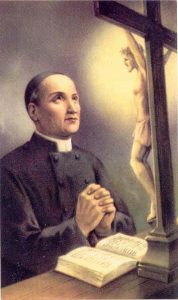MUNDELEIN SEMINARY
1000 EAST MAPLE AVENUE
MUNDELEIN IL 60060
February 22, 2016
Chair of St. Peter
Very dear Stigmatine Lay Member,
We are approaching the mid-way point of Lent – and in anticipation of a new spring-time, and of Laetare Sunday. This is a time likewise of Prophetic Joy – as also happens with the Third Sunday of Advent. We look forward in faith and hope to our Redemption as celebrated with the Sorrowful Stigmata of Good Friday. We need also to ponder a bit further, and look forward to the Healing and Glorious Stigmata of Easter Sunday. On this day, the Precious Blood and the Risen Body of the Lord are received together in the Holy Communion – as we ponder the words of Jesus regarding His own Mission: As the Father sent Me, now I am sending you…! Showing His Glorious Wounds, Jesus commits to us all to our share in His Personal Mission of revealing the Merciful Father’s face. This is known also as the “Apostolic Mission”, that same Mission He received personally from His Father, shared with His Apostles, and meant to be taken up by each of the baptized down through the centuries, and has nourished us with our every Amen at Holy Communion.
On this Feast of the Chair of St. Peter, each one of us is invited to ponder that share of the Cross committed to St. Gaspar in his Trinitarian, Christological, Ecclesial and Eucharistic vocation – one that was forged in St. Gaspar, deeply wounded by personal suffering for years on end. The Stigmatine Spirit gifted to us all challenges each of us in our deferential service in continuing Christ’s Mission in responding to the needs of the Church today, wherever we are. St. Gaspar has left behind a series of rather massive writings where he pondered two-fold aspects of the one mystery of the Most Sacred Stigmata. St. Gaspar did not have any “experiential” knowledge of the Sacred Wounds of the Lord, as has been attributed to St. Francis of Assisi and in the 20th century, the Franciscan, St. Pio.
However, there were very painful incidents in St. Gaspar’s life that profoundly affected him and his personal spirituality. It all enabled him as the long years of his went by, as he put on the mind of Christ Jesus [cf. Ph 2:5, ff.]. These would be:
- the deaths of his loved ones, with whom he shared his childhood years – particularly, perhaps his 3 year old sister, Matilda;
- the separation of his mother and father;
- some apostolic fear and trembling – as his “stage-fright’ in teaching catechism when his Bishop suddenly appearing to listen to him; or his assignment to help wayward priests, in some instances older than he was, and to guide them back to their priestly mission;
- life-long and extended illnesses and repeated painful lancing of leg ulcerations;
- the lack of development in the Congregation.
Perhaps much like St. Paul, St. Gaspar also experienced intimate solidarity with Christ, and bore something of a type of the stigmata of the Lord, bearing faithfully the “brand-marks of Jesus” [cf. Ga 6:17; 1 Co 4:11, ff.], “the sting of the flesh”. St. Gaspar certainly lived his “thorn” throughout so much of his life [cf. 2 Co 12:7], constantly making up “for what was lacking in the sufferings of Christ!” [cf. Col 1:24] in his deferential service for the much-troubled Church of his time. St. Gaspar was convinced that we are all called to live with Him in the power of God [2 Co 13:4]. This is one of the “modes”, manners of living the life of Jesus Christ. [cf. CF # 2]. This is how the Stigmatine Founder made a lifelong oblation [obsequium] to God’s Mercy [cf. Rm 12:1] of his sufferings in union with those of Jesus Christ.
One of the features of St. Gaspar’s voluminous writings is that there is hardly any explicit mention of the sublime doctrine in his special devotion to the Espousals of Mary and Joseph. But, his writings evidence a fuller appreciation of the integral Stigmata of Jesus Christ, i.e., the Sorrowful and Glorious dimensions of the one mystery.
There follows in Appendix I some excerpts on ‘The Integral Paschal Mystery’: first, a brief sampling of some of St. Gaspar’s writings [‘Meditations in Primum Regum’], and secondly a summary of my study ‘Stimmate Integre‘ (that can be found in full in the website ‘A Tribute to St. Gaspar Bertoni’ – www.st-bertoni.com – under ‘Life & Spirituality’).
Hoping that my efforts here are not too extended, this lengthy note is only meant for our personal Lenten reflections and an increase of our hope in the Mercy of God – uniquely manifested in the Healing Wounds of our Risen Lord.
Respectfully and lovingly in the Merciful Lord and His Healing Wounds,
Father Joseph Henchey, CSS
Acting Spiritual Director
APPENDIX I:
Stimmate Integre [The Integral Pascal Mystery] – by Rev. Joseph Henchey, CSS [2000]

